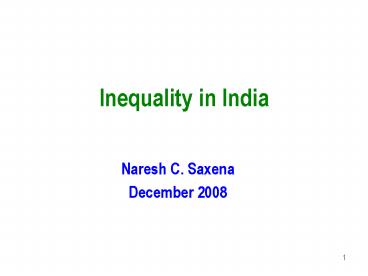Inequality in India - PowerPoint PPT Presentation
1 / 32
Title:
Inequality in India
Description:
Legitimacy of ethnic group solidarity and politics. Regional and linguistic Highest ... Thus groundwater was being monopolised by rich farmers, who also took advantage ... – PowerPoint PPT presentation
Number of Views:5930
Avg rating:3.0/5.0
Title: Inequality in India
1
Inequality in India
- Naresh C. Saxena
- December 2008
2
2
3
Dimensions of rising inequality
- Regional
- Urban-rural
- Social
- Gender
4
Indias social complexity
- Is there consensus on policies pertaining to
minorities? - as defined by
- Language
- Caste
- Gender
- Religion
5
Legitimacy of ethnic group solidarity and politics
- Regional and linguistic Highest
- Scheduled Tribes
- Women
- Scheduled Castes
- Backward Castes
- Muslims Lowest
6
Legitimacy of Indian minorities
7
(No Transcript)
8
Long Way to Go
- North and East lag way behind in
- Health
- Education
- Poverty
Source District Level Socio-economic
Development, India Today State of the States,
2004.
9
(No Transcript)
10
Child Sex Ratio 2001 (by district)
10
11
Index number of Agricultural Production
- Index
annual rate of growth - 1981-82 100
-
4.4 - 1990-91 148
-
2.8 - 1996-97 176
-
0.5 - 2006-07 183
12
(No Transcript)
13
(No Transcript)
14
Unemployment
- Current daily status (CDS) unemployment rate
increased from 6.1 in 1993-94 to 7.3 in 1999-00
to 8.3 in 2004-05 - Unemployment among agricultural labour households
sharply increased from 9.5 in 1993-94 to 15.3
in 2004-05 - Growth of real wages of these workers decelerated
strongly - Employment in the organised sectors declined
despite fairly healthy GDP growth - (Approach Paper, Planning Commission)
15
In the 1970s-1980s
- Agricultural output increased because of higher
investments in irrigation, new technology, seeds,
power and roads - Last fifteen years
- Despite higher output support price and input
subsidies production has stagnated - Falling public investment in agriculture
- No focus on backward regions/poor farmers
- Declining formal credit
- Falling groundwater levels, soil erosion
- Net irrigated area stagnating at 53 m ha
16
(No Transcript)
17
Tribal development
18
18
19
Indian Forest Cover
20
Reduction in poverty
20
21
(No Transcript)
22
Kendu leaf (KL) collection in Orissa
- Collectors are 1.5 million poorest - mostly women
- Govt gets 1.50 billion Rs as royalty - for every
Rupee to plucker, royalty is 3 Rs - Royalty on Bauxite is Rs 30 per tonne, on KL
12,000 Rs per tonne
22
23
Unresolved Issues
- Land alienation indebtedness
- Lack of proper rehabilitation after involuntary
displacement - Ineffective implementation of the Panchayats
(Extension to the Scheduled Areas) Act, 1996 - Tribals access to forests
- Shifting cultivation
- Poor programme delivery
- Political agitations vs rebellion
23
24
Thank you
25
Recommendations
- Fix quantifiable targets, such as reduction of
IMR by three percentage points every year - All tribal children to be covered by
supplementary nutrition, MDM and immunisation - 90 of vacant posts to be filled up within a year
- Absenteeism to be monitored by independent
monitors and reduced by 50 in a year - PDS monthly supplies would improve to 25 kg in a
year - Teaching in mother tongue
- Incentive for teachers/ health workers
- Link NREGA in tribal areas to forest regeneration
and water conservation, and locally relevant
livelihood - Stronger legislation on tribal land alienation
and usurious money lending - Link funds to states with performance
26
Water Famine in India How Real?
- During April-May 2000, the Maharashtra Government
in India was supplying drinking water through
tankers in about 3000 villages, many of these had
a well-irrigated sugarcane crop. Thus groundwater
was being monopolised by rich farmers, who also
took advantage of easy availability of two other
scarce resources electric power and capital.
The rich farmers thus transferred the
responsibility of satisfying peoples need for
drinking water to the state, with the state
abetting in the overuse of water by supplying
them cheap power. - Mid-term Review of the 9th Plan
- Planning Commission
27
Institutional credit for agriculture
- Has steadily fallen from 18 per cent of the total
bank credit in the mid-1980s to 10.0 per cent in
March 2003. - A substantial part of agricultural loans in the
1990s has been in the form of indirect credit,
that is, lending for various intermediary
agencies and deposits placed by banks in Rural
Infrastructure Development Fund (RIDF) in lieu of
priority sector lending. - In the same period there has been a precipitate
fall in small borrowal accounts (credit limits of
Rs 25,000 or below) from 62.55 million to 36.87
million, amount outstanding from 25 per cent to
5.4 per cent. - The number of rural branches has declined from
32,981 to 32,137
28
Policy Interventions
- More investment in irrigation, power, and roads
in poorer regions - Provide funds for maintenance of existing assets
- Focus on backward regions/poor farmers, and not
on high cost regions - Farmers of backward regions are badly hit by PDS
leakages - Promote water harvesting programs stricter
controls on groundwater extraction - Improve formal credit for small farmers
- Remove controls on movement, storage, and
processing - Monopoly of marketing by govt parastatals
- Permit leasing in by small farmers agr
labourers - Food Imports as a short term strategy
29
(No Transcript)
30
(No Transcript)
31
Employment is dominated by informal sector jobs
32
Wage Growth is heavily concentrated at the top end





























![[READ]⚡PDF✔ Dispossession without Development: Land Grabs in Neoliberal India (Modern South Asi PowerPoint PPT Presentation](https://s3.amazonaws.com/images.powershow.com/10067905.th0.jpg?_=20240628101)

